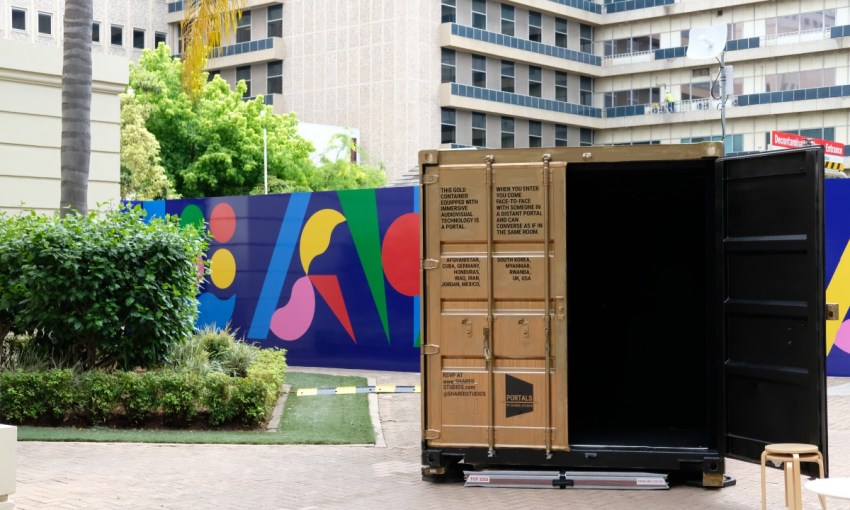In Shared Studio's Portal, the golden shipping container sat in front of oRAH, Johnny von Einem found the internet of days gone by.
A Portal to the past
As a 29-year-old Millennial, many of my most formative years were spent exploring digital spaces.
Even before Internet ubiquity, in the mid-1990s, when I was in third grade, students who finished bookwork early (young nerds like myself) were sent to the back of the room – where the (one lonesome) computer was located – and given access to a digital rendering of the entire world, led by the intrepid Carmen Sandiego.

Johnny von Einem is CityMag’s senior journalist.
By the late-1990s, my parents brought the internet into the family home, and with it came chat rooms, instant messaging, and a genuine link to the world beyond the border of my country town.
It quickly became habit to come straight home from school, log on, and flick between conversations with friends on MSN Messenger, wall posts on MySpace, games of computer-generated 8-ball against random individuals from chat rooms, and tracking snail-paced downloads on Kazaa.
Reading that back, it sounds like a sad and lonely high school experience, but there was camaraderie amongst those of us who chose to frontier into the relatively uncharted World Wide Web, rather than watch Neighbours in the living room.
It was a place to meet new people, explore the limits of your knowledge, and test your dumb teenage ideas in a community broader than the one you had access to offline.
Although I was sat at home, slumped in front of a screen, barely moving but to type and click, my memory of that time is physical – MSN wasn’t just a messaging platform, it was a space for my contemporaries and I to hang out and chat, and it felt as real to me as the school cafeteria at lunch time.
The internet of 2017 is a different place. In fact, it feels nothing like a place at all.
Post colonisation by Facebook and Google, and after the inexorable flood of online advertisements, the character of online spaces more closely resembles a barren and over-lit shopping plaza, populated more by products than people.
As the algorithm shaping our Facebook feeds further preferences the brands and personalities willing to pay for increased exposure, people are pushed out, and online spaces become impersonal.
With no people, there is no community, and with no community, the town square Mark Zuckerberg once aspired to becomes a dark alleyway of snark and insult.
Long I have yearned for an antidote to the current state of online spaces, this incessant and impersonal internet, and I have found it in a golden shipping container.
The Portal, created by Shared Studios and placed in front of the oRAH by Renewal SA, is a digital connector of people and places. It is essentially a box containing little more than four dark walls and a projector, which connects you via video link to another portal in another part of the world (there’s portals in countries as diverse as Rwanda, the Unites States, and Jordan). It’s a fairly simple set-up, but it resembles so much of what my experience of the internet once was.
I once had to come home to access my online life (social media platforms weren’t available on Nokia brick phones) and similarly the Portal only exists in one location; there are no sidebar advertisements to distract from the purpose of my visit; and most importantly, it’s personal – I’m standing directly across from Stephanie from Mission, Texas.
It’s not exactly like we’re sharing a room, but it is like sharing an online space, only now with the ability to make eye contact with the person you’re chatting to.
We spoke about work, religion, feeling both encumbered and loyal to the small towns we live in, and I left feeling nostalgic for a time before online interactions were reduced to likes and comment threads.
The nature of the internet is that it is constantly changing, morphing, and growing to become more practical to more people, being implemented to serve more ends across the world.
But as I understand it – and I type this fully aware of my utopian outlook – the purpose of this great connecting fabric is to hopefully bring about some form of global unity through increased communication and understanding.
That won’t come through the passive scrolling of feeds and shallow interaction of a double-tap on Instagram, but we might have a better chance if we hold onto some of the intimacy of the internet’s early years.




